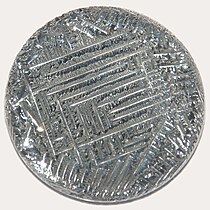Group 16
| Chalcogens | |||||||||||
|---|---|---|---|---|---|---|---|---|---|---|---|
|
|
|||||||||||
|
|||||||||||
| ↓ Period | |||||||||||
| 2 |
Oxygen (O) 8 Diatomic nonmetal |
||||||||||
| 3 |
Sulfur (S) 16 Polyatomic nonmetal |
||||||||||
| 4 |
Selenium (Se) 34 Polyatomic nonmetal |
||||||||||
| 5 |
Tellurium (Te) 52 Metalloid |
||||||||||
| 6 |
Polonium (Po) 84 Post-transition metal |
||||||||||
| 7 |
Livermorium (Lv) 116 Unknown chemical properties |
||||||||||
|
Legend
|
|||||||||||
|
NFPA 704 fire diamond |
|---|
| Fire diamond for the chalcogen selenium |
Legend
The chalcogens (/ˈkælkədʒɪnz/) are the chemical elements in group 16 of the periodic table. This group is also known as the oxygen family. It consists of the elements oxygen (O), sulfur (S), selenium (Se), tellurium (Te), and the radioactive element polonium (Po). The chemically uncharacterized synthetic element livermorium (Lv) is predicted to be a chalcogen as well. Often, oxygen is treated separately from the other chalcogens, sometimes even excluded from the scope of the term "chalcogen" altogether, due to its very different chemical behavior from sulfur, selenium, tellurium, and polonium. The word "chalcogen" is derived from a combination of the Greek word khalkόs (χαλκός) principally meaning copper (the term was also used for bronze/brass, any metal in the poetic sense, ore or coin), and the Latinised Greek word genēs, meaning born or produced.
Sulfur has been known since antiquity, and oxygen was recognized as an element in the 18th century. Selenium, tellurium and polonium were discovered in the 19th century, and livermorium in 2000. All of the chalcogens have six valence electrons, leaving them two electrons short of a full outer shell. Their most common oxidation states are −2, +2, +4, and +6. They have relatively low atomic radii, especially the lighter ones.
...
Wikipedia





